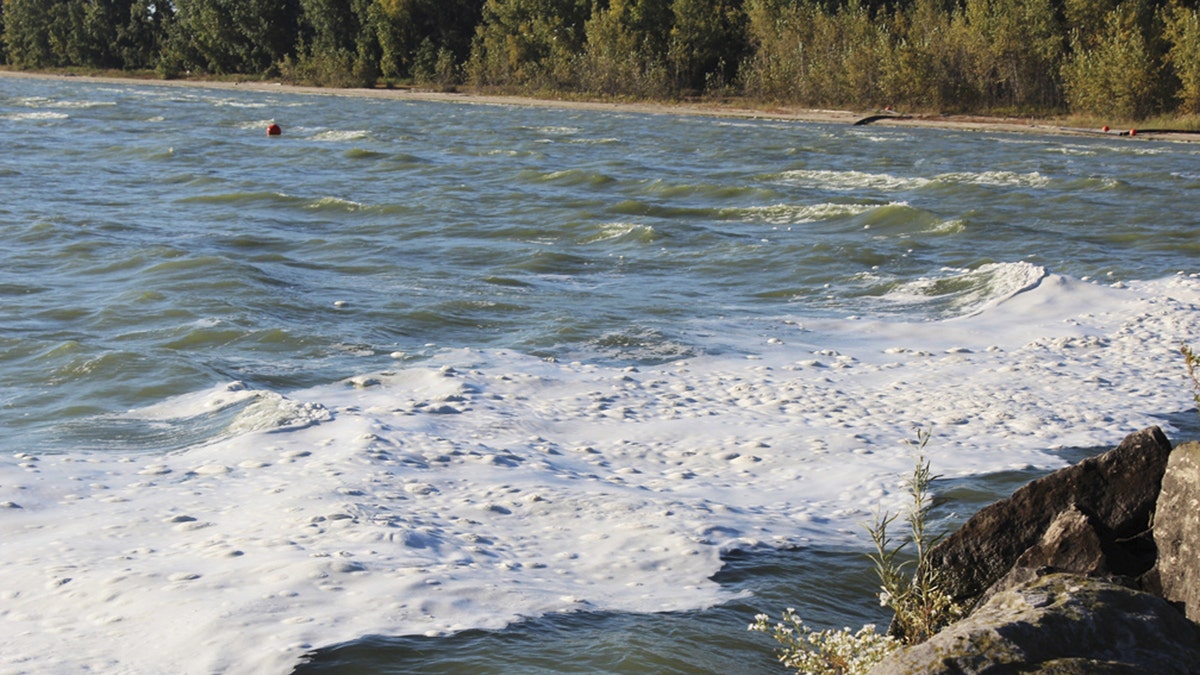
White foam created by a release of chemicals from dying algae blooms on western Lake Erie washes up on the break wall at West Harbor in Port Clinton, Ohio. (AP Photo/The Plain Dealer, D'Arcy Egan)
TOLEDO, Ohio – Toxins from blobs of algae on western Lake Erie are infiltrating water treatment plants along the shoreline, forcing cities to spend a lot more money to make sure their drinking water is safe.
It got so bad last month that one township told its 2,000 residents not to drink or use the water coming from their taps.
The cost of testing and treating the water is adding up quickly — the city of Toledo will spend an extra $1 million this year to combat the toxins while a neighboring county is considering a fee increase next year to cover the added expenses.
Algae blooms during the summer and early fall have turned the water into a pea soup color in recent years. The unsightly surface has scared away tourists, and toxins produced by the algae have contributed to oxygen-deprived dead zones where fish can't survive.
The toxins also are a threat to the drinking water that the lake provides for 11 million people.
The annual algae blooms have been concentrated around the western end of Lake Erie — though a few have spread to the Cleveland area — and have affected water treatment plants in Toledo and other cities that dot the water's edge in northern Ohio.
The algae growth is fed by phosphorous from farm fertilizer runoff and other sources, leaving behind toxins that can kill animals and sicken humans.
Tests on drinking water in Carroll Township, which is just west of Toledo, showed the amount of toxins had increased so much in early September that officials decided to order residents to stop using the water for two days until they could hook up to another water supply.
It was believed to be the first time a city has banned residents from using the water because of toxins from algae in the lake.
"I wasn't sure how dangerous it was, but we wanted to be cautious," said Henry Biggert, the township's water plant superintendent.
The township's treatment plant is now back online, but the water is being filtered and treated over a longer period to remove the toxins, he said.
What makes combating these toxins a challenge for operators of water treatment plants is that there are no standards on how to handle the problem or federal guidelines on what is a safe amount in drinking water. Plus, each water treatment facility is unique.
Plant operators along the lake in Ohio have been teaming up to figure out what works best.
"We're out there scrambling around," said Kelly Frey, Ottawa County's sanitary engineer. "It's just been do the best you can."
The county, he said, tests the water three times a week while adding a chemical called activated carbon to absorb the algae before filtering it. The expense of treating the water may require an increase in water rates next year of a couple of dollars a month for the average family, Frey said.
Toledo officials anticipated spending $3 million this year to treat its water, but the cost increased to $4 million because it has needed more chemicals to treat the toxins from the algae. That's about double what the city spent just a few years ago.
"We can throw a little more money and defeat it for a while," said David Leffler, the city's commissioner of plant operations.
But the larger issue, he said, is how to cut down on the amount of phosphorus from farm fertilizer and other sources that run off into the lake and feed the algae blooms.
His biggest fear is that the toxins could overwhelm Toledo's treatment plant and force officials to shut down its water supply to the state's fourth largest city and its suburbs. "It keeps me up at night," he said.
